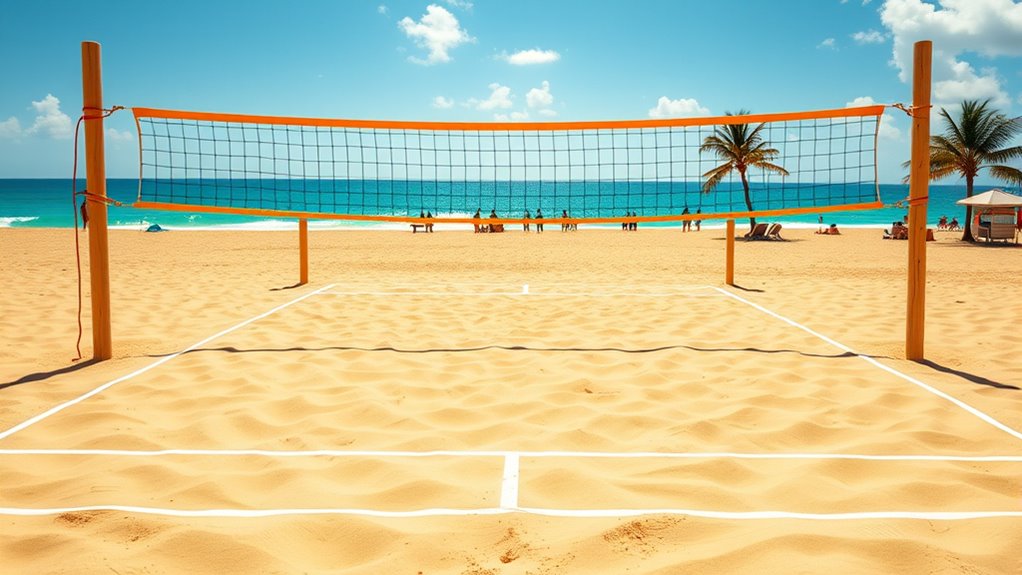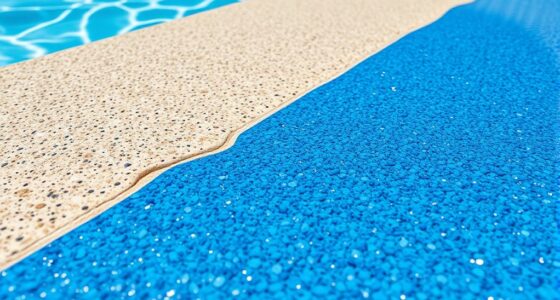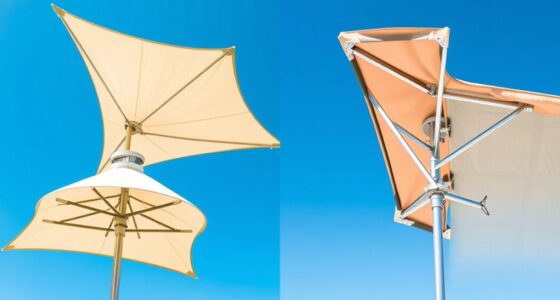To set up a regulation beach volleyball court, start by choosing a flat, well-drained sandy area and clear debris. Mark the court boundaries accurately, guaranteeing it measures 16m by 8m with proper sidelines, end lines, and center lines. Install sturdy, adjustable net posts at the correct height—2.43m for men or 2.24m for women—and tension the net evenly. Add proper lighting, fencing, and safety barriers for night or outdoor play, and ensure all elements meet official standards for safe, competitive gameplay. Continue to learn how each step guarantees a top-quality court.
Key Takeaways
- Select a flat, well-drained surface with appropriate sand depth and quality for safety and consistent play.
- Mark court boundaries, attack line, and service zones accurately using weather-resistant paint or tape.
- Install and tension the net to official height standards (2.43m for men, 2.24m for women), ensuring stability.
- Ensure proper lighting for night games, aiming for 200-300 lux with even distribution and minimal glare.
- Set up durable safety barriers and secure fencing to contain balls and protect players.
Understanding Official Dimensions and Layout
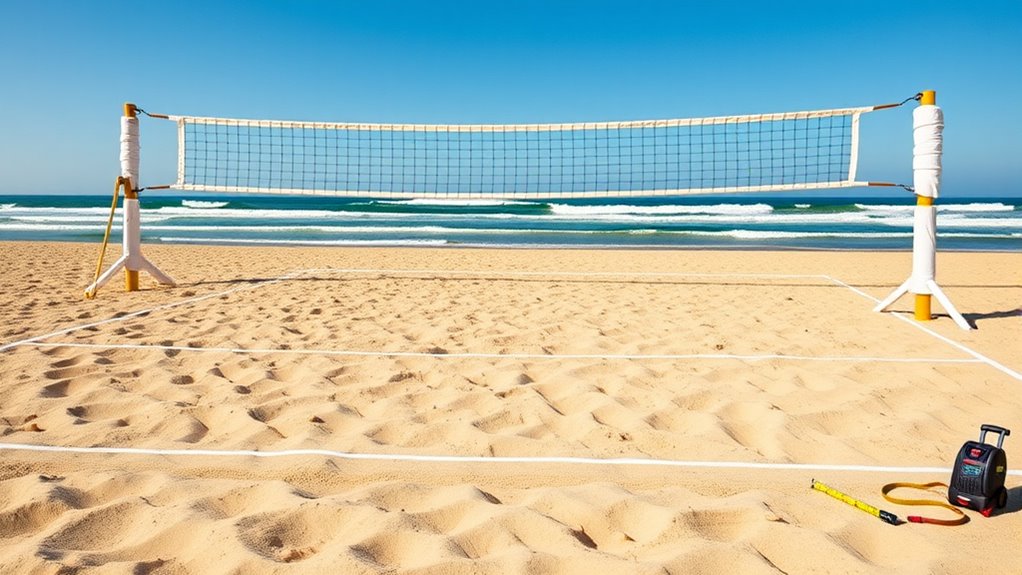
To guarantee fair play and consistency, it’s vital to comprehend the official dimensions and layout of a beach volleyball court. The court measures 16 meters long and 8 meters wide, providing enough space for dynamic movement and strategic plays. The boundary lines should be clearly marked, with lines at least 5 centimeters wide, ensuring visibility for players and officials. The net is positioned in the center, 2.43 meters high for men and 2.24 meters for women, dividing the court equally. The attack line runs parallel to the net, 3 meters from it, defining front and backcourt areas. Properly understanding these measurements helps you set up a compliant court that promotes fair competition and enjoyable gameplay. Additionally, official regulations specify that the surface must be level, firm, and free of hazards to ensure player safety and optimal game conditions. Paying attention to court surface materials can greatly influence safety and playability, making it a crucial consideration during setup.
Selecting the Right Location and Site Preparation
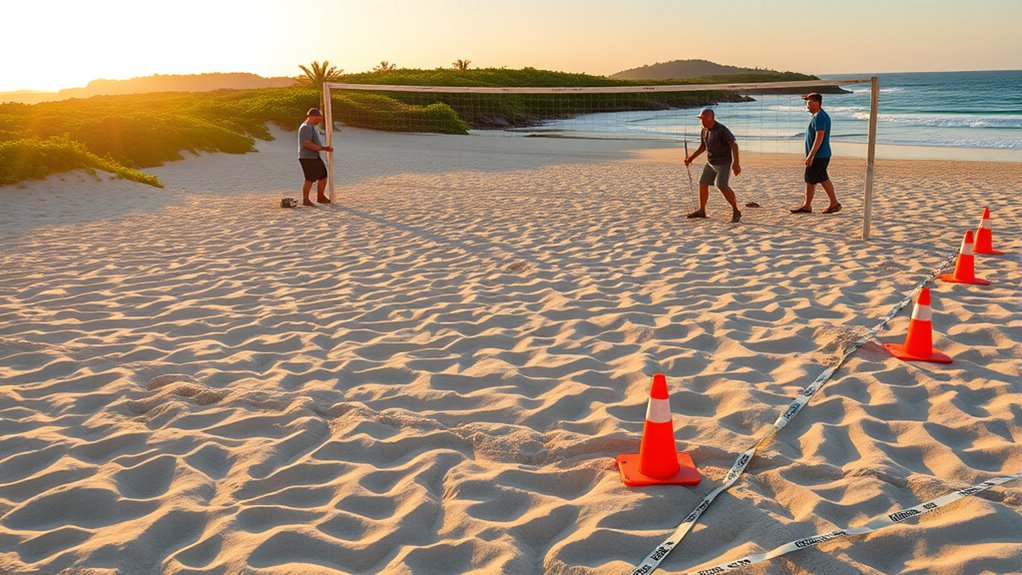
Choosing the right location for your beach volleyball court sets the foundation for safe, enjoyable play. Look for a flat, well-drained area with plenty of space around the court to prevent injuries and allow movement. Avoid shaded areas that could cause uneven surface conditions or slippery spots. Consider accessibility for players and spectators, as well as proximity to amenities like water and restrooms. Prepare the site by clearing debris, rocks, or roots that could interfere with play. Ensure the surface is level and stable to support proper footing. Use the table below to help evaluate potential sites:
| Criteria | Considerations |
|---|---|
| Flatness | Avoid slopes or uneven terrain |
| Drainage | Prevent pooling during rain |
| Accessibility | Easy access for players and spectators |
| Space Availability | Enough room for court and safety zones |
| Surface Stability | Firm enough to support volleyball activities |
Additionally, assessing the surface stability is crucial to ensure consistent play and reduce the risk of injuries. A well-prepared site with proper drainage systems can significantly improve playing conditions. Incorporating adequate leveling techniques can further enhance surface uniformity and safety. Furthermore, understanding how geotechnical factors influence soil stability can help prevent future issues with the court surface. Proper site analysis, including soil testing, can provide insights into foundational integrity and long-term durability of the court.
Designing and Marking the Court Boundaries

Have you considered how precise boundary markings can enhance both the safety and fairness of your beach volleyball game? Clear, accurate lines define the play area, prevent disputes, and guarantee compliance with official standards. Use durable, weather-resistant materials such as paint or tape specifically designed for sand surfaces. Measure carefully to maintain the correct dimensions of 16 meters long and 8 meters wide, with boundary lines at least 5 cm wide. Mark the sidelines, end lines, and center line distinctly. Properly aligned boundaries help players judge plays accurately and prevent accidental crossings. Additionally, ensuring accurate measurements from the start can save time and effort in maintaining the court over time.
Choosing Suitable Surface Materials for Beach Volleyball
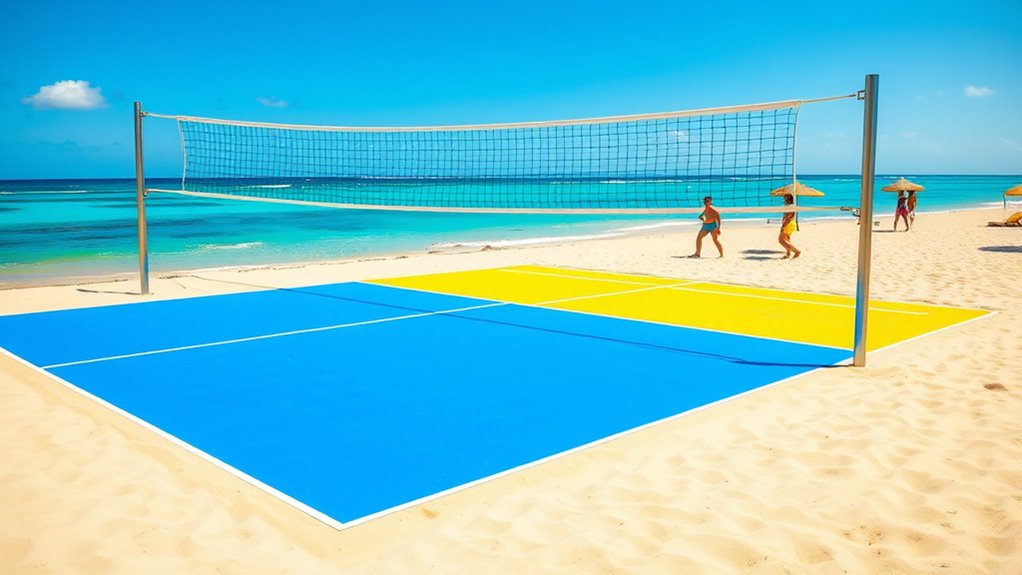
Selecting the right surface materials is essential for creating a safe and playable beach volleyball court. You want a surface that provides good traction to prevent slips and falls, especially when players are diving or sliding. Typically, fine, firm sand is the best choice because it offers cushioning, reduces injury risk, and maintains consistent ball bounce. Make sure the sand is free of debris, sharp objects, and foreign materials that could cause injuries. The sand should also be deep enough—around 40 cm—to absorb impact and provide stability. Properly chosen sand ensures a safe, uniform, and high-quality playing surface for competitive matches. Additionally, maintaining proper surface depth is crucial for optimal performance and safety during play. For optimal safety, it is also important to regularly inspect and maintain the surface to prevent uneven areas or compaction that could affect play and safety. Regular surface maintenance helps preserve the quality of the playing surface and reduces the risk of injuries caused by unsafe conditions. Incorporating best practices in surface care can further prolong the lifespan of the court and enhance player experience. Ensuring that the sand composition remains consistent over time is vital to maintaining its cushioning and playability qualities.
Installing the Net System and Height Regulations

Installing the net system correctly is crucial for compliance with regulation standards and guaranteeing consistent gameplay. Begin by securely anchoring the posts into the ground, making sure they are stable and aligned. Adjust the net to the official height—2.43 meters (7 feet 11 5/8 inches) for men and 2.24 meters (7 feet 4 1/4 inches) for women—using a calibration tool for accuracy. Ensure the net is taut and evenly tensioned to prevent sagging. Proper installation minimizes disputes and maintains fairness during matches. Regularly inspect the net system and maintenance procedures to ensure ongoing safety and compliance with regulations. Incorporating sound measurement tools can help maintain precise tension and height standards over time. Additionally, verifying measurement accuracy periodically can prevent deviations from official standards. Consistent checks and adjustments are essential for maintaining regulation compliance throughout the playing season. Moreover, understanding standardized procedures for setup can streamline the installation process and ensure consistency across different courts.
Setting Up Boundary Lines and Additional Markings

To make certain fair play, you need to set up boundary lines accurately and clearly. Using proper line materials and precise marking techniques makes a big difference in court visibility. When done correctly, these steps help players stay within the rules and avoid disputes. Additionally, ensuring that your court adheres to regulation standards helps maintain fairness and consistency during matches.
Accurate Line Placement
Ensuring the boundary lines and additional markings are accurately placed is essential for a fair and consistent game. Precise line placement defines the playable area and helps prevent disputes during play. Use a measuring tape or a calibrated tool to confirm the lines are exactly the correct distance from the court’s edges. Make sure the lines are straight and securely fixed, with no gaps or overlaps that could cause confusion. Pay attention to the markings for the attack line, center line, and service zones, ensuring they are correctly positioned relative to the court dimensions. Utilizing predictive modeling can assist in verifying that markings meet official standards based on previous court setups and measurements. Accurate measurements are crucial to meet official regulations for length, width, and zone placements. Ensure measurements match official regulations for length, width, and zone placements. Ensure lines are visible and free of obstructions or damage. Double-check that all markings align precisely with the court’s layout, and consider regular maintenance to preserve their clarity and accuracy over time. Additionally, inspecting the material quality of the lines can help prevent premature fading or deterioration, ensuring long-term accuracy and visibility. Incorporating quality materials designed specifically for sports courts can further enhance durability and visibility over time.
Proper Line Materials
Have you chosen the right materials to set up your boundary lines and markings? Using durable, weather-resistant materials is essential for longevity and clear visibility. Vinyl or polyethylene tape works well because it’s lightweight, easy to install, and withstands sun, wind, and moisture. Ensure the tape is brightly colored, usually white or contrasting colors, so it’s easily seen by players and officials. For more permanent markings, consider using painted lines with high-quality outdoor paint designed for sand or concrete surfaces. Whichever material you choose, make sure the lines are properly anchored and taut, preventing sagging or movement that could interfere with gameplay. Proper line materials guarantee precise boundary definition and maintain the court’s professional appearance over time. Additionally, understanding bank SWIFT/BIC codes can be useful if you need to handle international transactions related to your sports facility.
Clear Marking Techniques
Accurate and visible boundary lines are essential for smooth gameplay and proper officiating. To guarantee clarity, use high-contrast, durable marking materials that withstand weather conditions. Properly tape or paint the boundary lines, ensuring they are straight and clearly defined. Regularly inspect and maintain markings to prevent fading or smudging. Additional markings, such as service zones and attack lines, should be equally precise and visible. Consider the following for effective marking techniques:
- Use weather-resistant paint or tape for long-lasting visibility
- Measure and mark lines with precision tools to ensure accuracy
- Keep markings consistent in width and color throughout the court
These steps help players and referees interpret boundaries correctly, minimizing disputes and ensuring fair play.
Ensuring Proper Lighting for Night Play
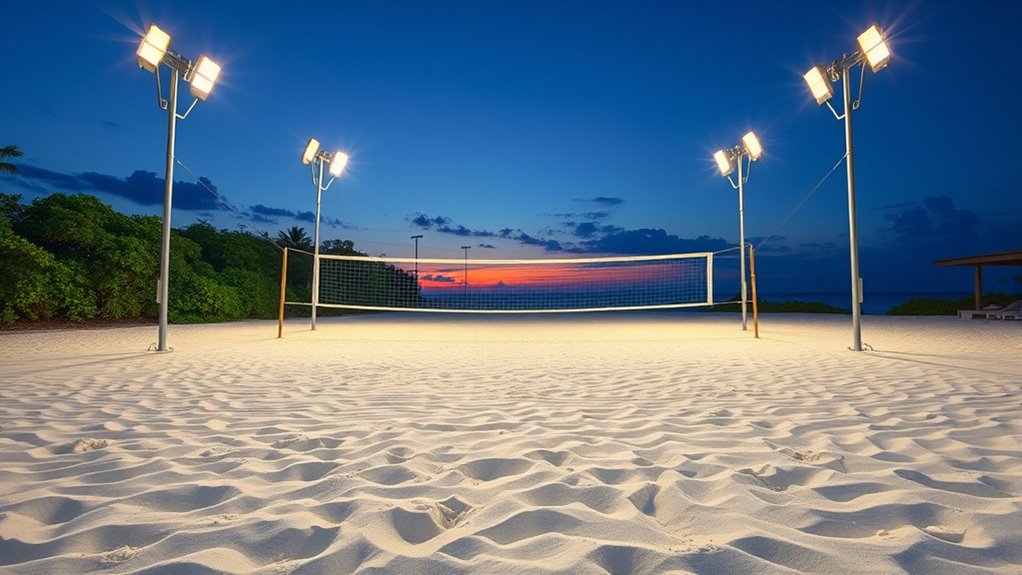
Proper lighting is essential to keep night play safe and enjoyable on a regulation beach volleyball court. You need bright, evenly distributed lights that eliminate shadows and dark spots, so players can see the ball clearly and move confidently. Use high-quality floodlights or LED fixtures mounted on tall poles around the court’s perimeter, aiming them downward to minimize glare. Make sure the lighting covers the entire court without creating blind spots. Adjust the brightness to meet a recommended lux level for volleyball, typically around 200-300 lux. Regularly inspect and maintain the lighting system to guarantee consistent performance. Proper lighting not only enhances visibility but also reduces the risk of injuries and allows for extended play hours, making your court functional and safe after sunset.
Installing Fencing and Safety Barriers

Installing fencing and safety barriers around your beach volleyball court is essential for preventing balls from leaving the play area and ensuring player safety. Proper barriers help keep the game contained, reduce the risk of injuries, and maintain a clear boundary for players. Choose fencing materials like mesh or netting that are durable and weather-resistant, ensuring longevity. The height of the barriers should be sufficient to contain standard game balls and prevent accidental escapes. Securely anchoring the fencing to the ground prevents movement during play. Consider the following for added functionality:
- Material selection for durability and weather resistance
- Optimal height for game containment
- Secure anchoring techniques for stability
Adding Essential Equipment and Accessories
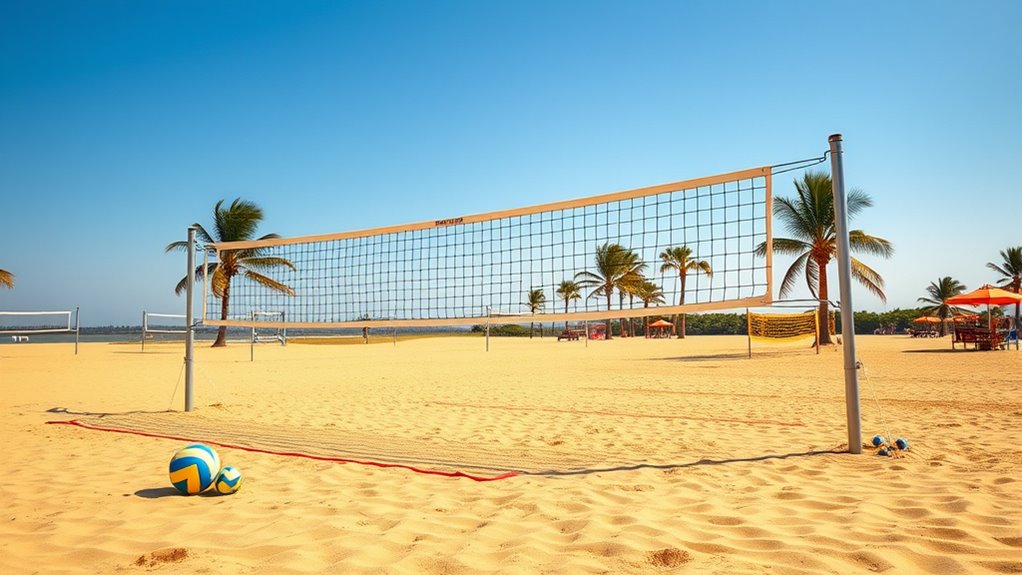
Adding the right equipment and accessories enhances your beach volleyball court’s functionality and safety. You’ll need a high-quality net that meets regulation height, along with sturdy poles that are properly anchored. Consider including boundary lines that clearly mark the court’s limits, ensuring players stay within the playing area. Portable scoreboards and ball holders can streamline gameplay and keep the court organized. You might also add corner flags or markers for better visibility from a distance. To improve safety, place padding around poles or other hard surfaces. Ensure you have enough volleyballs for practice and matches. Ultimately, incorporating shade structures or benches nearby helps players rest comfortably. These essential accessories create a well-equipped, safe environment that encourages consistent play and enjoyment.
Conducting Final Inspection and Maintenance Tips

Before hitting the court for play, it’s essential to conduct a thorough final inspection to guarantee everything is in top condition. Check the net for proper tension and secure attachments, ensuring it’s at regulation height. Examine the boundary lines for clarity and integrity, replacing any worn or faded sections. Inspect the sand for levelness, removing debris or foreign objects that could cause injury. Regular maintenance keeps the court safe, prolongs equipment lifespan, and ensures ideal play.
- Verify net tension and height adjustments
- Confirm boundary lines are visible and intact
- Rake and level the sand to maintain a smooth surface
Frequently Asked Questions
What Permits or Approvals Are Needed to Build a Beach Volleyball Court?
When you’re planning to build a beach volleyball court, you’ll need to check local regulations first. You might require permits from your city or county, especially if you’re building on public land or near sensitive areas. Contact your local zoning or planning department to find out what approvals are necessary. Also, verify your project meets safety and environmental standards, and get any permits before starting construction to avoid fines or delays.
How Do Weather Conditions Affect Court Material Selection and Maintenance?
Weather conditions are the silent sculptors of your court’s fate. Heavy rains can erode your surface, while intense sun can crack and fade materials. You need to choose durable, weather-resistant materials like concrete or specialized synthetic surfaces that withstand moisture, UV rays, and temperature fluctuations. Regular maintenance, such as sealing and cleaning, helps preserve your court’s integrity, ensuring it remains a resilient playground through every season’s whims.
What Are the Best Practices for Drainage to Prevent Water Accumulation?
Good drainage is essential to keep your court playable and safe. You should guarantee the court has a slight slope, about 1-2%, to direct water away from the playing surface. Installing proper drainage systems like underground pipes or surface drains helps prevent water accumulation. Regularly clear debris from drains to maintain efficiency. Using permeable materials for the surface also allows water to seep through quickly, reducing puddles and ensuring consistent play.
How Can I Make the Court Accessible for Players With Disabilities?
You can make the court accessible for players with disabilities by ensuring smooth, even surfaces free of obstacles. Use ramps with gentle slopes at entrances, and install wide pathways for wheelchair access. Incorporate tactile paving for the visually impaired, and provide accessible seating areas. Clear signage and proper lighting also help. By designing thoughtfully, you create an inclusive space where everyone can enjoy playing comfortably and safely.
What Are Cost-Effective Ways to Maintain Court Quality Over Time?
Imagine your court as a living entity needing care to thrive. To keep it in top shape without breaking the bank, you should regularly inspect and repair surface damages, keep the sand clean, and control vegetation around the area. Use affordable, locally sourced materials for repairs, and schedule routine maintenance. These simple steps will guarantee your court remains in excellent condition, providing a safe, enjoyable experience for players over time.
Conclusion
Setting up a beach volleyball court is like crafting a perfect sandcastle—you need attention to detail and the right foundation. Imagine your friends playing under the sunset, laughter echoing as you’ve carefully marked boundaries and installed the net. With proper planning and maintenance, your court becomes a thriving hub of fun and competition. Remember, a well-built court isn’t just a space—it’s where memories are made, just like that first epic rally that stays in your heart forever.

